Isle of Foula
The Island
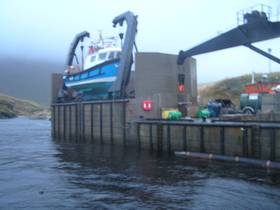

Foula is Britain's most remote inhabited island. It is situated in the Atlantic Ocean approximately 20 miles to the west of the Shetland mainland. The island currently has a population of 25 residents. Travel to the island is by sea or air and is completely dependent on suitable weather conditions.
It is an island of crofting townships, breathtaking sheer cliff drops, and a wealth of wild flowers and wildlife.
For more information on Foula visit www.foulaheritage.com
Further details of the project here:
Living at the edge of the world The Guardian
Islanders feel the power of green energy The Observer




The Project
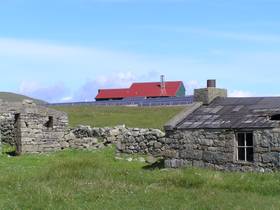

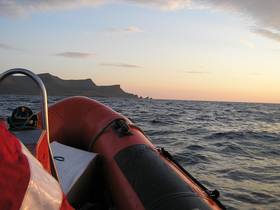


The island of Foula is not connected to any mainland electricity grid system. In 1987 a community electricity scheme was constructed, comprising a 3.3kV island grid which linked diesel generators, a wind turbine and a hydroelectricity scheme to the island’s properties.
This scheme gradually fell into disrepair and in 2007 underwent a major refurbishment, funded primarily through grants.
The transformers and control system were replaced; a new photovoltaic (PV) array installed; battery storage and associated inverters integrated into the system; and the hydro generator system refurbished with the addition of a second pipeline.
The project received funding assistance from: Shetland Islands Council, Shetland Enterprise, Highlands and Islands Energy Company, European Regional Development Fund, Energy Saving Trust, Big Lottery Fund. This is a three phase network with all generation and consumption at 400/230 Vac. In order to transmit power around the island network with minimal cable sizes whilst reducing power losses over the distances involved a number of transformers are used to first step-up power from the generation to 3.3kV and then down again for consumption.
Before refurbishment, the entire island's power was supplied by one of the two diesel generators which operated between approximately 7.20am and 00.30am.
Typical island load would vary between 12kW and 22kW during that period.
The renewable generation was specified to optimise energy output around the year. The battery storage system manages the discrepancies between periods when power is available and when it is required by the island load. The hydro generator will provide the bulk of the island’s baseload during the winter months, supplemented by small amounts of energy from the PV array. During the summer months, the island would still rely on the diesel generators, but the battery storage system and PV array will help to minimise the diesel generator run time. During the summer, the energy from the hydro generator and the PV array will help to reduce diesel fuel consumption. Because of the northerly latitude of Foula long hours of daylight are experienced over summer months so output from the PV system is very significant. The system provides 24-hour power and the battery storage was sized to supply a small overnight load, comprising of fridges, freezers, central heating pumps and a few lights.
Load controllers within properties allow any surplus hydro energy to be employed by water or space heaters when the batteries become fully charged. This new electrical system for Foula was designed by Econnect Ventures who worked with Wind & Sun Ltd to design the battery, inverter & PV system.










Battery/Inverter System
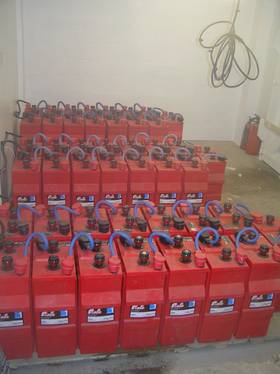
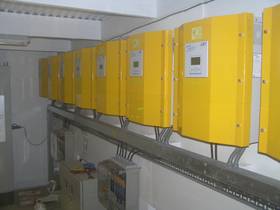
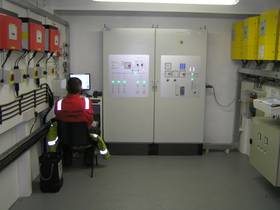
Wind & Sun designed the battery/inverter system and PV array and installed it in November 2006 and January 2007. The system uses 9 Sunny Island SI-4500 bi-directional inverters as the heart of the system to combine to give a high quality sine wave inverter with powerful overload capability (total of 40kW 30min rating). They include high performance battery chargers that ensures maximum battery lifetimes, energy management controller for loads and generators, and a generator management system.
All generation is connected on the AC side with the PV using Sunny Boy inverters, so cable volt losses can then be minimised. Three 3-phase clusters of inverters are used with each cluster connected to it’s own battery bank rated at 60 VDC 916 Ah (@ C10 rate) and comprising 15 x 4V Rolls Solar RB-4KS21PS batteries. This gives a total storage capacity for the whole system of over 80 kWh to 50% depth of discharge.
The Sunny Island inverters control the battery charging and the system is designed to tie in with the existing diesel generators. One of these generators is selected at a time and can be controlled from the Sunny Island.
The generators have a so called ‘droop characteristic’ which means they reduce their frequency analogously to the load and vary their output voltage versus the apparent power. Generators are only needed if loads exceed inverter capacity or if the batteries needed recharging.






PV System
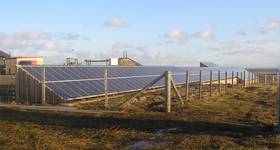
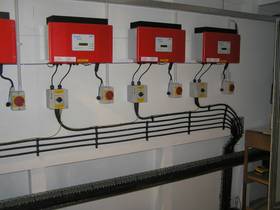

The 19.2kWp PV array consists of 6 sub-arrays each comprising of 2 strings of 20 BP Solar BP380S 80Wp PV modules. (240 modules in total). The modules are mounted on a galvanised steel ground mount framework designed and constructed by Malakoff Ltd (the Shetland based main contractors for the electrification project). Malakoff also mounted the PV modules ready for wiring by Wind & Sun. A large concern during the design process was to ensure that the entire system would last a long time. Foula experiences extreme weather (173mph winds have been recorded) so the PV modules were chosen for being the strongest available. Malakoff undertaking the mechanical installation ensured that their knowledge of the local conditions resulted in a robust solution and a smooth construction. Since Foula is so remote the simple logistics of getting materials to site safely and on time is significant, the wet peat ground conditions necessitated many tons of concrete alone, so this was no mean feat!
Each of the six 3.2kWp PV sub-arrays is connected via underground armoured cable to a SMA Sunny Boy SB-3000 inverter. These are designed for ordinary AC grid connection. They synchronise themselves with the grid voltage automatically when the sun comes up. The power from the PV contributes to the consumer loads on the system. Any surplus energy is used by the Sunny Island inverters to charge the batteries for later use.
The Sunny Boy inverters are set to Off-Grid mode to enable their power output to be controlled by the Sunny Island inverters. If there is too much renewable power being input to the system and the batteries become fully charged the Sunny Island inverters raise the grid frequency. As the grid frequency rises to 51 Hz, the PV inverters start to reduce their output linearly, until at 52Hz they are outputting no power. This removes the need for conventional charge controllers and ensures optimal battery charging.
The PV array is located outside the island primary school and community hall. A display was fitted at the entrance so everyone including visitors to the island can see exactly how well the PV's are working.
The system was originally monitored using a Sunny Control Plus unit with an analogue telephone modem allowing performance to be monitored remotely which is invaluable for system set-up, diagnosis and control.





